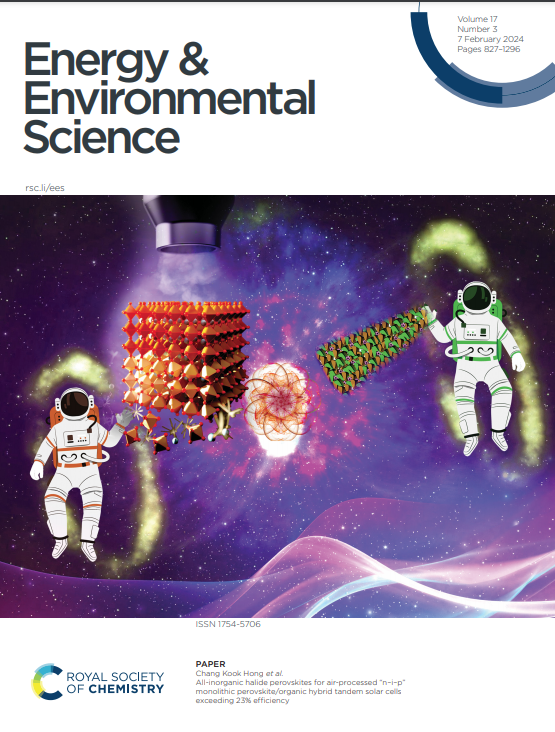High-Power Hydrogel-Based Moisture-Electric Generators
IF 30.8
1区 材料科学
Q1 CHEMISTRY, MULTIDISCIPLINARY
引用次数: 0
Abstract
Moisture-electric generators (MEGs) represent an emerging off-grid energy technology capable of generating electricity from ambient humidity; however, the power density and operational durability of existing MEG devices remain suboptimal, hindering their practical applications. Herein, we present a high-performance, highly flexible MEG achieved by integrating reduced graphene oxide (rGO) nanosheets and LiCl into a polyacrylamide (PAM) hydrogel matrix (namely PGL). The rGO nanosheets serve as conductive nanochannels that facilitate rapid ion transport and charge redistribution, synergizing with hygroscopic LiCl to boost output. By combining experiments, molecular-level simulations, and theoretical modeling, we establish rational and robust design principles for the intricate electricity generation process governed by chemicalmass transport-electric coupling, effectively guiding device design and enabling performance prediction. The resulting MEG unit achieves a superior open-circuit voltage of 0.6 V and a short-circuit current of 0.58 mA/cm 2 , which previously required hundreds of MEGs connected in parallel. Notably, our MEG banks connected in series and parallel are demonstrated to power wearable devices with integrated electronics. This work highlights a significant advancement in the design and scalability of MEGs, paving the way for their integration into flexible electronics and wearable technologies.大功率水凝胶湿发电机
湿电发电机(meg)代表了一种新兴的离网能源技术,能够从环境湿度中发电;然而,现有MEG器件的功率密度和工作耐久性仍然不理想,阻碍了它们的实际应用。在此,我们提出了一种高性能,高柔性的MEG,通过将还原氧化石墨烯(rGO)纳米片和LiCl集成到聚丙烯酰胺(PAM)水凝胶基质(即PGL)中来实现。还原氧化石墨烯纳米片作为导电纳米通道,促进快速离子传输和电荷再分配,与吸湿性LiCl协同提高输出。通过实验、分子水平模拟和理论建模相结合,我们为化学-质量传递-电耦合控制的复杂发电过程建立了合理而稳健的设计原则,有效地指导了装置设计和实现了性能预测。由此产生的MEG单元实现了0.6 V的优越开路电压和0.58 mA/ cm2的短路电流,而以前需要数百个MEG并联连接。值得注意的是,我们的串联和并联MEG银行已被证明可以为集成电子设备的可穿戴设备供电。这项工作突出了meg在设计和可扩展性方面的重大进步,为其集成到柔性电子和可穿戴技术中铺平了道路。
本文章由计算机程序翻译,如有差异,请以英文原文为准。
求助全文
约1分钟内获得全文
求助全文
来源期刊

Energy & Environmental Science
化学-工程:化工
CiteScore
50.50
自引率
2.20%
发文量
349
审稿时长
2.2 months
期刊介绍:
Energy & Environmental Science, a peer-reviewed scientific journal, publishes original research and review articles covering interdisciplinary topics in the (bio)chemical and (bio)physical sciences, as well as chemical engineering disciplines. Published monthly by the Royal Society of Chemistry (RSC), a not-for-profit publisher, Energy & Environmental Science is recognized as a leading journal. It boasts an impressive impact factor of 8.500 as of 2009, ranking 8th among 140 journals in the category "Chemistry, Multidisciplinary," second among 71 journals in "Energy & Fuels," second among 128 journals in "Engineering, Chemical," and first among 181 scientific journals in "Environmental Sciences."
Energy & Environmental Science publishes various types of articles, including Research Papers (original scientific work), Review Articles, Perspectives, and Minireviews (feature review-type articles of broad interest), Communications (original scientific work of an urgent nature), Opinions (personal, often speculative viewpoints or hypotheses on current topics), and Analysis Articles (in-depth examination of energy-related issues).
 求助内容:
求助内容: 应助结果提醒方式:
应助结果提醒方式:


